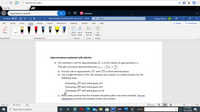
Advanced Engineering Mathematics
10th Edition
ISBN: 9780470458365
Author: Erwin Kreyszig
Publisher: Wiley, John & Sons, Incorporated
expand_more
expand_more
format_list_bulleted
Concept explainers
Question

Transcribed Image Text:Approximations explained with calculus
1) The mechanic’s rule for approximating \(\sqrt{a}\) is to first obtain an approximation \(x_1\). Then get successive approximations by \(x_{n+1} = \frac{1}{2} \left( x_n + \frac{a}{x_n} \right)\).
a) Use the rule to approximate \(\sqrt{11}\) and \(\sqrt{13}\) to three decimal places.
b) Use a single iteration of the rule and give your answer as a mixed number for the following cases:
- Estimating \(\sqrt{27}\) with initial guess of 5
- Estimating \(\sqrt{82}\) with initial guess of 9
- Estimating \(\sqrt{97}\) with initial guess of 10
c) With some practice that first iteration should be able to be done mentally. Give an explanation of what one iteration of the rule involves.
Expert Solution
This question has been solved!
Explore an expertly crafted, step-by-step solution for a thorough understanding of key concepts.
Step by stepSolved in 3 steps

Knowledge Booster
Learn more about
Need a deep-dive on the concept behind this application? Look no further. Learn more about this topic, advanced-math and related others by exploring similar questions and additional content below.Similar questions
- sdiUyxIC-ca6DLLOE19kax-gSuXEOq1sthqcdS TajAIOwGsNw/formResponse This option This option Question* Using Newton's method, the approximation of the root of the function f(x) = x2-3 accurate to within 10-1 starting with x, = 1 is: 1.7321 None of the answers This option This option 0.8526 0.8285 This option This option Question* For a given function f(x), the divided differences table is given by:arrow_forwardİn calculations , use four digits after the decimal point (do not round intermediate calculations)arrow_forward
Recommended textbooks for you
 Advanced Engineering MathematicsAdvanced MathISBN:9780470458365Author:Erwin KreyszigPublisher:Wiley, John & Sons, Incorporated
Advanced Engineering MathematicsAdvanced MathISBN:9780470458365Author:Erwin KreyszigPublisher:Wiley, John & Sons, Incorporated Numerical Methods for EngineersAdvanced MathISBN:9780073397924Author:Steven C. Chapra Dr., Raymond P. CanalePublisher:McGraw-Hill Education
Numerical Methods for EngineersAdvanced MathISBN:9780073397924Author:Steven C. Chapra Dr., Raymond P. CanalePublisher:McGraw-Hill Education Introductory Mathematics for Engineering Applicat...Advanced MathISBN:9781118141809Author:Nathan KlingbeilPublisher:WILEY
Introductory Mathematics for Engineering Applicat...Advanced MathISBN:9781118141809Author:Nathan KlingbeilPublisher:WILEY Mathematics For Machine TechnologyAdvanced MathISBN:9781337798310Author:Peterson, John.Publisher:Cengage Learning,
Mathematics For Machine TechnologyAdvanced MathISBN:9781337798310Author:Peterson, John.Publisher:Cengage Learning,


Advanced Engineering Mathematics
Advanced Math
ISBN:9780470458365
Author:Erwin Kreyszig
Publisher:Wiley, John & Sons, Incorporated

Numerical Methods for Engineers
Advanced Math
ISBN:9780073397924
Author:Steven C. Chapra Dr., Raymond P. Canale
Publisher:McGraw-Hill Education

Introductory Mathematics for Engineering Applicat...
Advanced Math
ISBN:9781118141809
Author:Nathan Klingbeil
Publisher:WILEY

Mathematics For Machine Technology
Advanced Math
ISBN:9781337798310
Author:Peterson, John.
Publisher:Cengage Learning,

